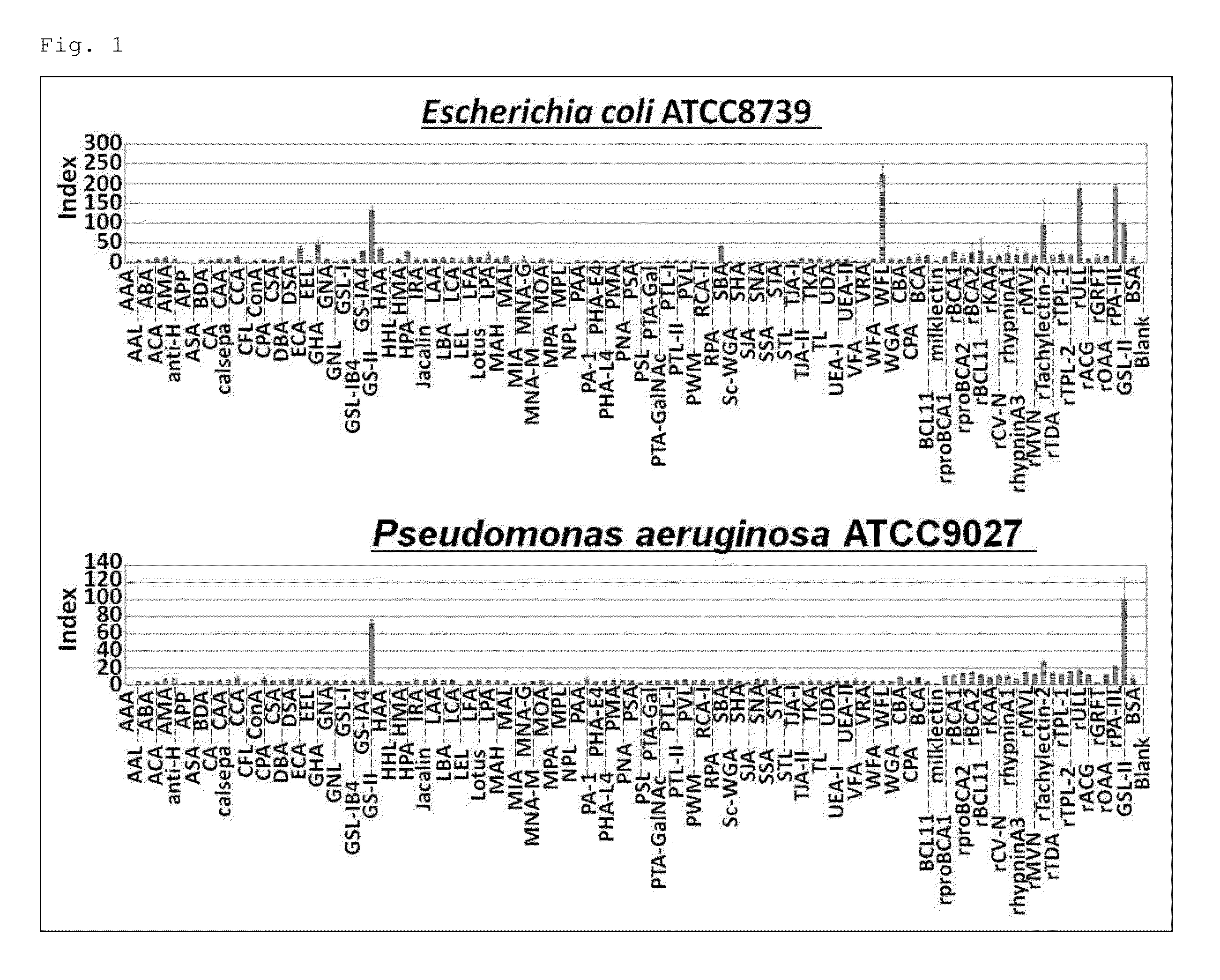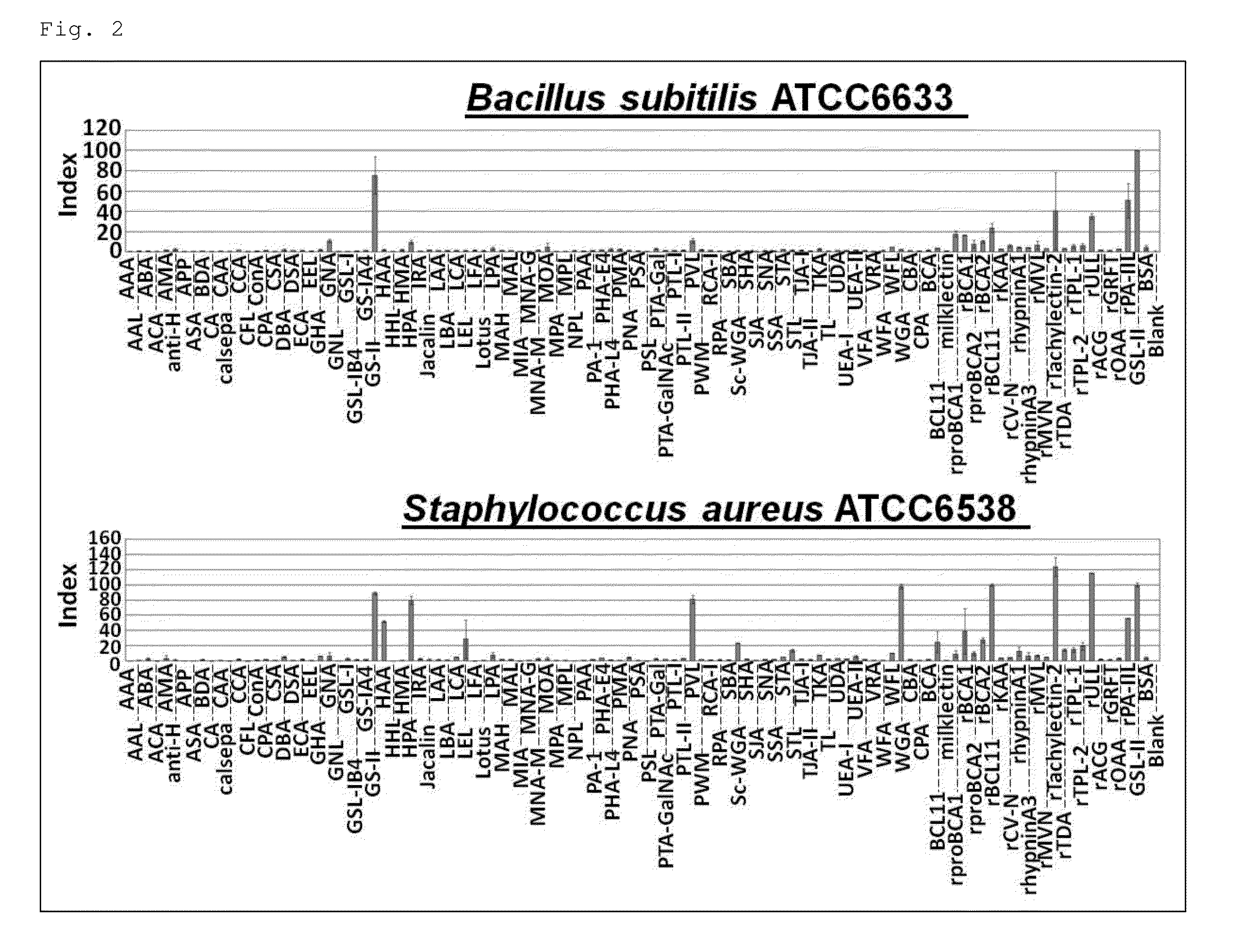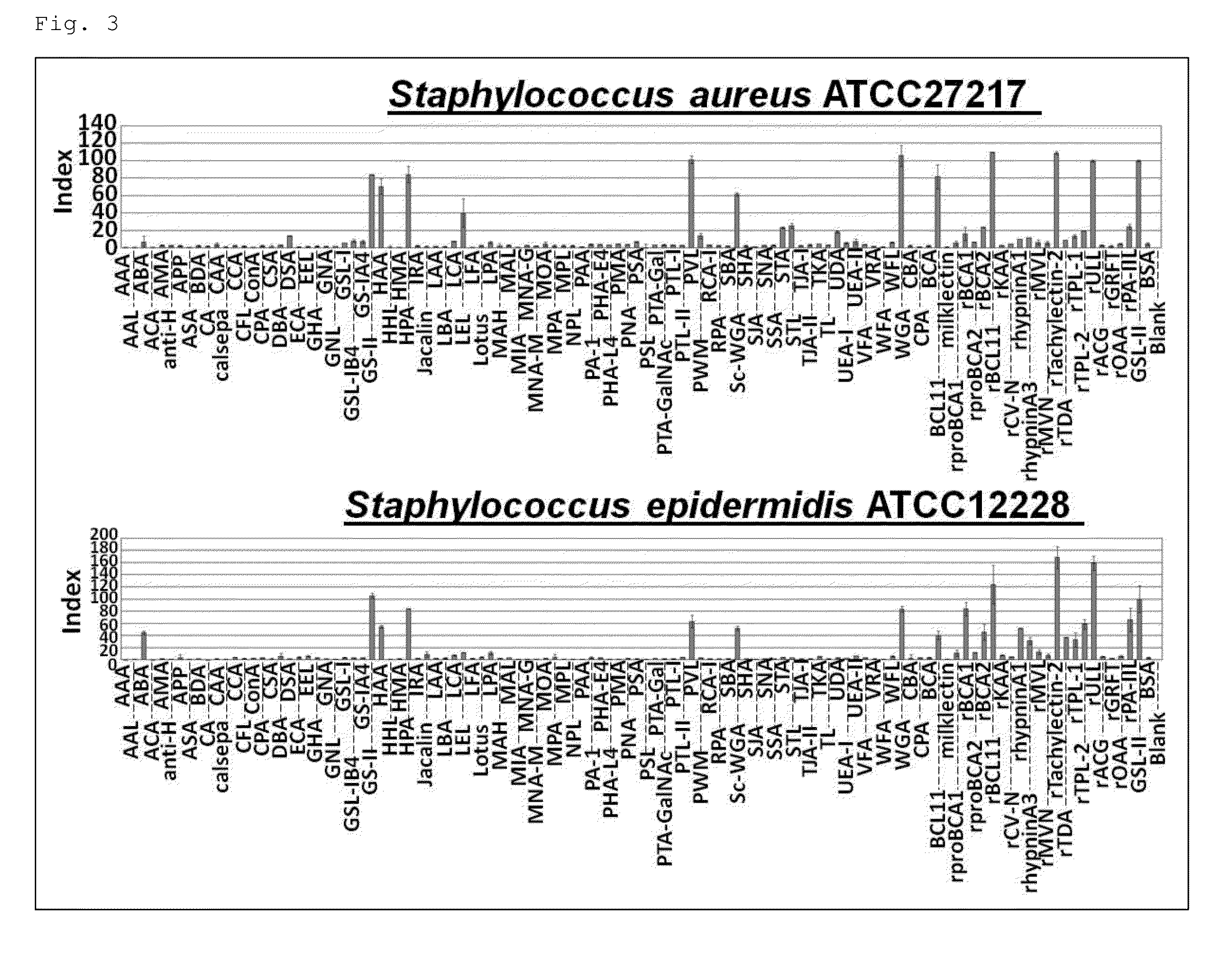Method for distinguishing between species within the genus staphilococcus
a technology of staphylococcus and species, applied in the field of methods for distinguishing between species within the genus staphylococcus, can solve the problems of inability to detect bacteria, inability to monitor real-time the proliferation of bacteria, and difficulty in distinguishing between species within the genus i>staphylococcus, etc., and achieve the effect of distinguishing species
- Summary
- Abstract
- Description
- Claims
- Application Information
AI Technical Summary
Benefits of technology
Problems solved by technology
Method used
Image
Examples
example 1
Screening of Lectins Capable of Binding to Bacteria at Stationary Phase
[0213]
[0214]Screening of lectins was carried out using commercially available lectins, purified lectins from natural extracts, and recombinant lectins. The lectins used will be described below. Commercially available lectins:
(Manufactured by EY Laboratories, Inc.)
[0215]AAA, ACA, AMA, APP, ASA, BDA, CA, CAA, calsepa, CCA, CPA, CSA, GHA, GS-IA4, GS-II, HMA, HPA, IRA, LAA, LBA, LFA, LPA, MIA, MNA-G, MNA-M, MOA, MPA, PAA, PMA, PSL, PTA-Gal, PTA-GalNAc, RPA, SHA, STA, TKA, TL, UDA, UEA-II, VFA, VRA, and WFA.
(Manufactured by Vector Laboratories Inc.)
EEL, GNL, GSL-I, GSL-IB4, GSL-II, HHL, Jacalin, LEL, MAH, MAL, MPL, NPL, PTL-I, PTL-II, RCA-I, Sc-WGA, SJA, SNA, STL, and WFL.
(Manufactured by Seikagaku Corporation)
[0216]AAL, ABA, anti-H, ConA, DBA, DSA, ECA, GNA, LCA, Lotus, PHA-E4, PHA-L4, PNA, PSA, PWM, SBA, SSA, TJA-I, TJA-II, UEA-I, and WGA.
(Manufactured by Sigma-Aldrich Corporation)
CFL, HAA, and PA-I
(Manufactured by ...
example 2
Selection of Lectins Capable of Distinguishing Between Staphylococcus aureus at Stationary Phase and Staphylococcus epidermidis at Stationary Phase
[0229]The above-described absorbance data was used to perform the significance test, and the lectins capable of distinguishing between Staphylococcus aureus at the stationary phase and other Staphylococcus (a skin resident Staphylococcus; Staphylococcus epidermidis) at the stationary phase were selected. The obtained results together with the conditions of the significance test are shown in Table 5. Note that, in examples 2-8, the statistical differences were confirmed by Student's t-test (two-sided test). In cases where unequal variances were suspected by F-test, Welch's t-test (two-sided test) was performed. Further, “P<0.05” was determined to be statically significant.
TABLE 5Analysis ConditionsType of Test: T testS.aureus (Group 1) S.aureus ATCC 6538 S.aureus ATCC 27217S.epidermidis (Group 2) S.epidermidis ATCC 12228 S.epidermidis ATCC...
example 3
Selection of Lectins Capable of Distinguishing Between Staphylococcus aureus at Stationary Phase and Staphylococcus capitis at Stationary Phase
[0231]The above-described absorbance data was used to perform the significance test, and the lectins capable of distinguishing between Staphylococcus aureus at the stationary phase and other Staphylococcus (a skin resident Staphylococcus; Staphylococcus capitis) at the stationary phase were selected. The obtained results together with the conditions of the significance test are shown in Table 6.
TABLE 6Analysis ConditionsType of Test: T testS.aureus (Group 1) S.aureus ATCC 6538 S.aureus ATCC 27217S.capitis (Group 2) S.capitis ATCC 27840 S.capitis ATCC 35661significance level: 0.05 ns no significant difference *: p Group 1Group 1Group 2Group 2MeanStandardMeanStandardLectinsValueDeviationValueDeviationT valueP valueHAA0.96880.04490.50670.018713.42870.0055**LEL0.59000.02831.27350.17895.33690.0334*rTachylectin-21.34680.03571.78300.09126.29820.0243...
PUM
| Property | Measurement | Unit |
|---|---|---|
| Fraction | aaaaa | aaaaa |
| Mass | aaaaa | aaaaa |
| Mass | aaaaa | aaaaa |
Abstract
Description
Claims
Application Information
 Login to View More
Login to View More - R&D
- Intellectual Property
- Life Sciences
- Materials
- Tech Scout
- Unparalleled Data Quality
- Higher Quality Content
- 60% Fewer Hallucinations
Browse by: Latest US Patents, China's latest patents, Technical Efficacy Thesaurus, Application Domain, Technology Topic, Popular Technical Reports.
© 2025 PatSnap. All rights reserved.Legal|Privacy policy|Modern Slavery Act Transparency Statement|Sitemap|About US| Contact US: help@patsnap.com



